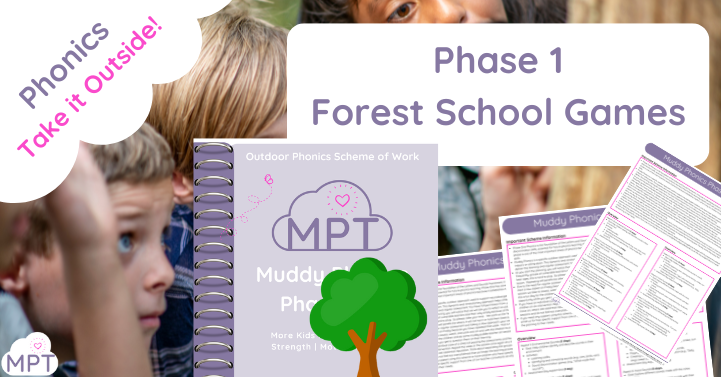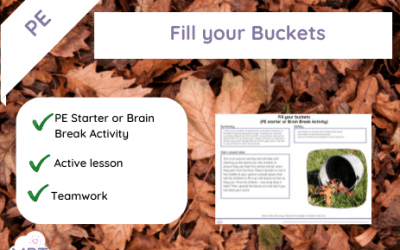The Floor is Lava (Outdoor Team Building Game) ⇒Use The Floor is Lava (Outdoor Team Building Game) to take your...
Glorious Graffiti Game
Nov 9, 2021
Glorious Graffiti Game - 10-minute art brain break ⇒Use Glorious Graffiti Game to take your children outside while...
Arty Brain Breaks: Muddy Art Attack
Oct 18, 2021
Arty Brain Breaks: Muddy Art Attack Five Reasons Going Outdoors Helps with Children's Mental Health Remember,...
Arty Brain Breaks: Halloween Art Challenge
Oct 18, 2021
Arty Brain Breaks: Halloween Art Challenge Five Reasons Going Outdoors Helps with Children's Mental Health ...
Arty Brain Breaks : Muddy Mazes
Oct 18, 2021
Use our Arty Brain Breaks to take your children outside in active ways while still nurturing, embedding and...
Spellbound Spellings – Year 5/6 Spellings (Set Five)
Oct 18, 2021
Spellbound Spellings – Year 5/6 Spellings (Set Five) Five Reasons Going Outdoors Helps with Children's Mental Health ...
Spellbound Spellings – Year 5/6 Spellings (Set Four)
Oct 18, 2021
Spellbound Spellings – Year 5/6 Spellings (Set Four) Five Reasons Going Outdoors Helps with Children's Mental...
Spellbound Spellings – Year 5/6 Spellings (Set Three)
Oct 18, 2021
Spellbound Spellings – Year 5/6 Spellings (Set Three) Five Reasons Going Outdoors Helps with Children's Mental...
Spellbound Spellings – Year 5/6 Spellings (Set Two)
Oct 18, 2021
Spellbound Spellings - Year 5/6 Spellings (Set Two) Five Reasons Going Outdoors Helps with Children's Mental Health ...
Spellbound Spellings – Year 5/6 Spellings (Set One)
Oct 18, 2021
Spellbound Spellings - Year 5/6 Spellings Five Reasons Going Outdoors Helps with Children's Mental Health ...
Cop 26 2021 Glasgow Lesson Plan
Oct 12, 2021
Try some of these introduction activities Take the children outside and explain to the children that COP 26 is...
Sticky Races (PE Starter or Brain Break)
Sep 21, 2021
Sticky Races (PE Starter or Brain Break) Five Reasons Going Outdoors Helps with Children's Mental Health ...
The Shopping Basket Warm-Up
Sep 21, 2021
The Shopping Basket Warm-Up Five Reasons Going Outdoors Helps with Children's Mental Health Remember, you need...
Fill your Buckets (PE Starter or Brain Breaks)
Sep 21, 2021
Outdoor Brain Breaks: Boosting Learning and Well-being Brain breaks are short mental breaks taken during regular...
Stoney Islands (PE Starter or Brain Break)
Sep 21, 2021
Stoney Islands (PE Starter or Brain Break) Five Reasons Going Outdoors Helps with Children's Mental Health ...
Leaf Tag (PE Starter or Brain Break)
Sep 21, 2021
Leaf Tag (PE Starter or Brain Break) Five Reasons Going Outdoors Helps with Children's Mental Health Remember, you...
Andy Goldsworthy (Outdoor Art)
Sep 21, 2021
Andy Goldsworthy (Outdoor Art) Five Reasons Going Outdoors Helps with Children's Mental Health Remember, you...
KS2 Adding ones, tens and hundreds to three-digit numbers
Sep 20, 2021
KS2 Adding ones, tens and hundreds to three-digit numbers Why should every good teacher take their learning...
New In

Forest School Games Phase Six

Forest School Games Phase Five

Forest School Phase 2 Phonics

Forest School Phonics Games (Phase One)

Phase 6 Phonics Games (Parachutes)

Phase 5 Phonics Games (Parachutes)

Phase Four Phonics Games (Parachutes)

Phase 3 Phonics Games (Parachutes)

Phase 2 Phonics Games (Parachute)




















